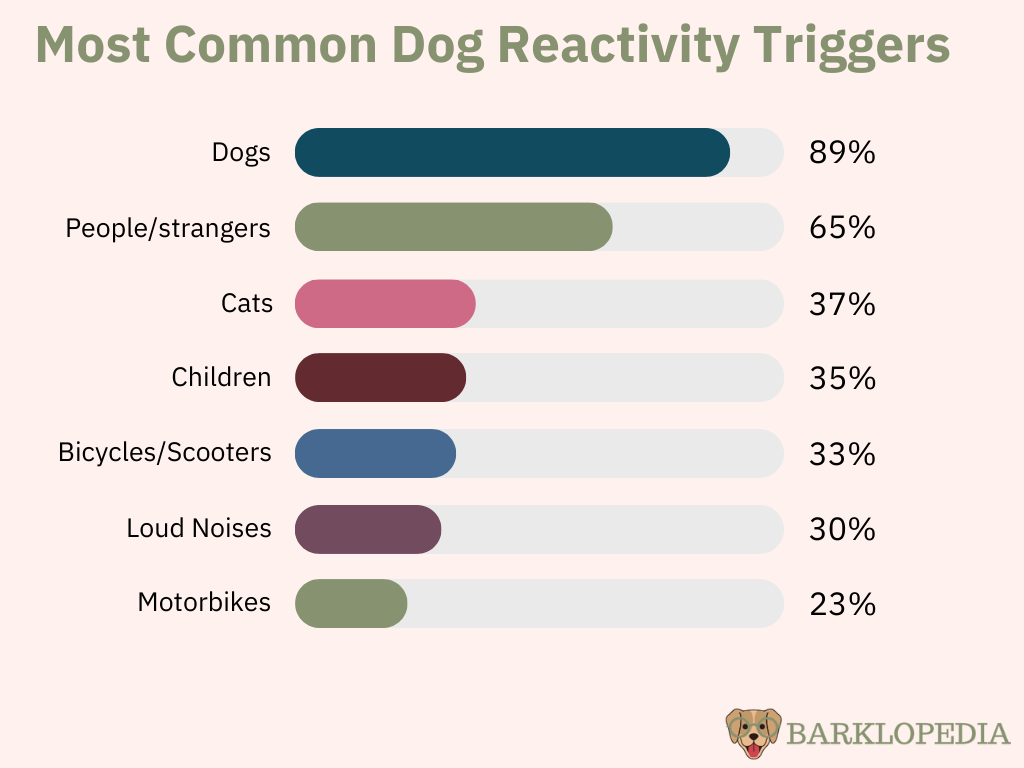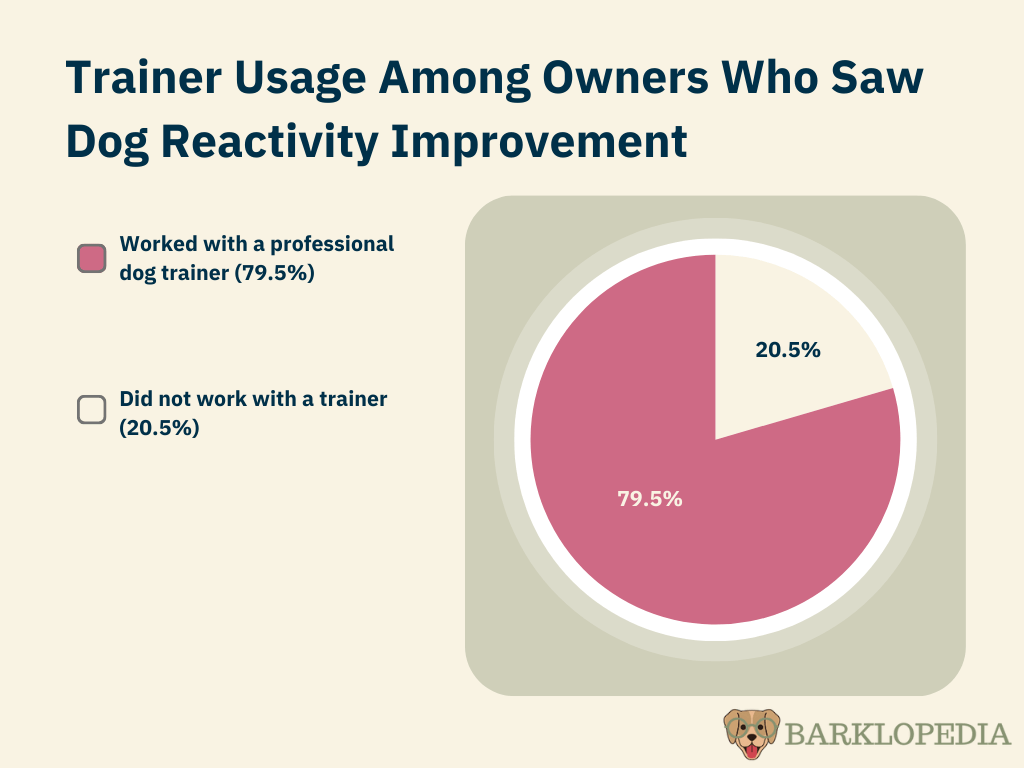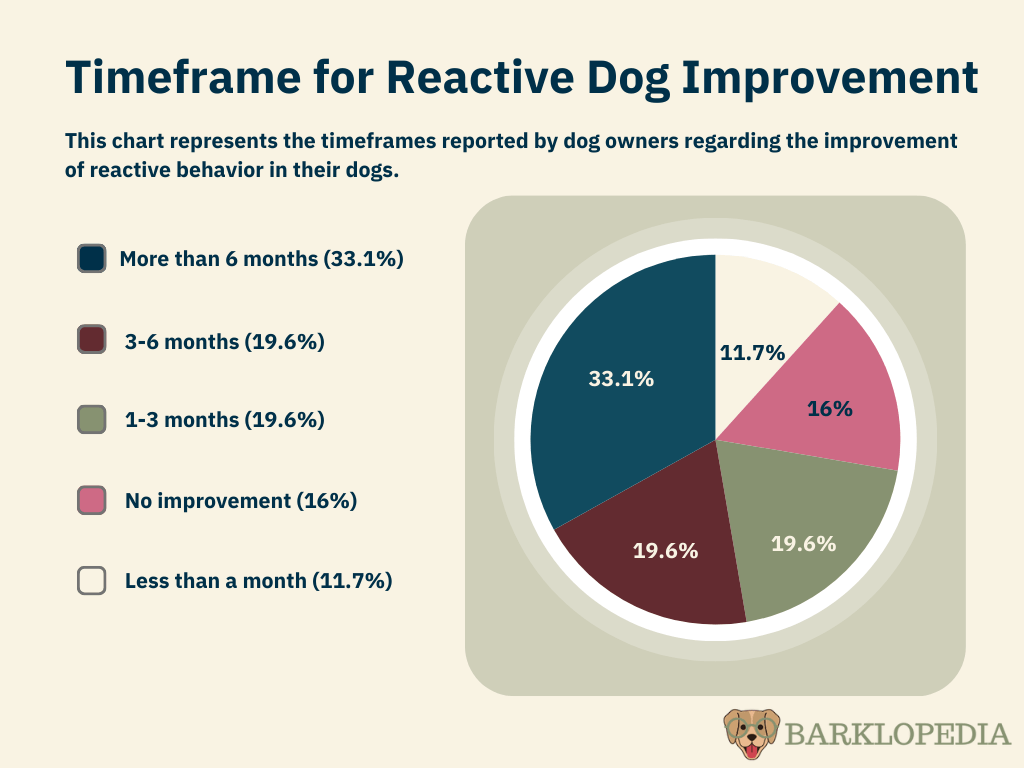I know firsthand the challenges and emotional toll that comes with trying to manage your dog’s reactivity. However, through my journey and the experiences of other reactive dog owners, I’ve learned that the right training techniques can make a significant difference. Based on feedback from 120 dog owners who have successfully reduced their dog’s reactivity, here’s a comprehensive look at the most effective training methods.
Common Triggers for Dog Reactivity
Understanding the triggers that cause reactivity in dogs is crucial for tailoring effective training strategies. The following chart summarizes the most common triggers reported by dog owners, highlighting the specific situations or stimuli that frequently provoke reactive behaviors.

Identifying common triggers for dog reactivity helps in applying appropriate training techniques. For instance, other dogs are the most frequent trigger, impacting over 89% of dogs, while people or strangers affect about 65%. Cats and young children also trigger reactivity in 37% and 35% of dogs respectively. Additionally, stimuli such as bicycles, scooters, and loud noises affect around 30% of dogs, with motorbikes affecting about 23%.
Given these triggers, techniques like positive reinforcement and counter-conditioning are highly relevant. Positive reinforcement can help by rewarding calm behavior when the dog encounters these triggers, reinforcing desirable responses. Counter-conditioning can be used to change the dog’s emotional response to these stimuli, helping them associate the triggers with positive experiences rather than fear or aggression. By understanding and addressing these common triggers, owners can apply these techniques effectively to manage and reduce their dog’s reactivity.
Patience, space, work, and love are essential for managing a reactive dog
Is It Possible To Cure Reactivity?
Based on feedback from reactive dog owners, a complete “cure” for dog reactivity might not always be achievable, but significant improvements are definitely possible.
From my own experience, I noticed early on after adopting my dog that he was highly reactive – lunging and barking at people and other dogs made outings to the park stressful and challenging. Fast forward a year, and while he’s not “cured” of his reactivity, our day-to-day life has become much more enjoyable. This mirrors what many other owners have reported: while 47 people saw significant improvement and 77 experienced some positive changes, 30 others either saw no noticeable improvement or found that their dog’s reactivity worsened.
The variability in results highlights that while reactivity may not be entirely eliminated, dedicated training and management can lead to a much more manageable and rewarding experience with your dog.
| Progress in Managing Dog Reactivity Owner Feedback | Number of Responses |
|---|---|
| Significant Improvement | 47 |
| Some Improvement | 77 |
| Unsure | 11 |
| No Noticeable Improvement | 17 |
| Worsened | 13 |
Most Successful Training Techniques for Reactive Dogs
Here is a summary table displaying the most commonly reported dog training techniques by the reactive dog owners:
| Training Technique | Number of Owners Reporting Success with Technique | Percentage of Owners (%) |
|---|---|---|
| Positive reinforcement | 118 | 98.3% |
| Desensitization | 101 | 84.2% |
| Counter-conditioning | 70 | 58.3% |
| Clicker training | 53 | 44.2% |
| Use of tools (e.g., prong/shock collar) | 50 | 41.7% |
| Head halter | 2 | 1.7% |
| Behavior Adjustment Training (BAT) | 2 | 1.7% |
| Gentle Leader | 1 | 0.8% |
| Enforced rest | 1 | 0.8% |
| Aromatherapy | 1 | 0.8% |
| Mantrailing | 1 | 0.8% |
| Long walks | 1 | 0.8% |
| Enrichment activities | 1 | 0.8% |
1. Positive Reinforcement (98.3%)
Nearly every owner reported using positive reinforcement as their primary training technique.
What is positive reinforcement? This method involves rewarding your dog with treats, praise, or play when they display desirable behavior. It’s especially effective in helping dogs associate triggers with positive outcomes, ultimately changing their emotional response.
2. Desensitization (84.2%)
Desensitization is another highly effective method used by 84.2% of the owners.
What is desensitization? This technique involves gradually exposing your dog to the trigger at a low intensity and increasing the exposure over time, allowing them to become accustomed to it without reacting.
3. Counter-Conditioning (58.3%)
Counter-conditioning, reported by 58.3% of owners, works hand-in-hand with desensitization.
What is counter-conditioning? This technique focuses on changing the dog’s negative association with a trigger to a positive one, usually by pairing the trigger with something the dog loves, like treats.
4. Clicker Training (44.2%)
Clicker training, used by 44.2% of respondents.
What is clicker training? A form of positive reinforcement where a clicker sound is used to mark the desired behavior, followed by a reward. This method can help dogs quickly associate the behavior with the reward.
5. Use of Tools (41.7%)
A significant number of owners (41.7%) reported using tools such as prong or shock collars. While these tools can sometimes be controversial, they were used by some owners as part of their training regimen. However, these tools should only be used under the guidance of a professional trainer.
Notes:
- The percentages are calculated based on a total of 120 responses gathered through a survey completed by contributors in the Reactive Dogs subreddit and a Reactive Dog Support group on Facebook.
- Many owners reported using multiple techniques simultaneously.
Owning a reactive dog has been challenging but educational. Despite the difficulties, the small victories make it worth it.
Do I need a professional dog trainer?
In my own experience, working with a professional trainer was a game-changer. Shortly after adopting my reactive dog, I realized that I needed help to understand his specific fears and unique personality traits. The trainer not only gave me the confidence to start socializing my dog again but also helped me correct some bad leash-handling habits I had unknowingly developed. Looking back, it’s clear that we wouldn’t have made the progress we did without professional guidance.
This is reflected in the feedback from other owners, where 79.5% of those who saw improvement also worked with a trainer, emphasizing the significant role that expert help can play in managing and improving dog reactivity.

Other Techniques and Insights
While the above techniques were the most commonly reported, several other methods were also mentioned. Techniques like Behavioral Adjustment Training (BAT), head halters, and even aromatherapy were used by a small percentage of owners. Each of these methods has its place, depending on the specific needs and triggers of the dog.
Patience and consistency from the owner are key. The dogs don’t know better, and it’s our job to work hard with them and understand their needs.
How Long Will It Take to See Improvement in My Reactive Dog?
In my own experience, we noticed some progress after just a few training sessions. We quickly learned that part of my dog’s reactivity was driven by his eagerness to meet other dogs, and the trainer helped us manage this through controlled introductions. However, the most significant changes were observed after a year, coinciding with my dog’s adjustment period since he had only been with me for a year.
According to the data from other owners, 11.7% saw improvements in less than a month, while 19.6% noticed progress within 1-3 months and another 19.6% within 3-6 months. The majority, 33.1%, experienced noticeable changes only after more than 6 months. This range of experiences underscores that improvement timelines can vary widely, and patience combined with consistent training is crucial for managing and reducing dog reactivity.

| Timeframe for Improvement | Number of Responses | Percentage (%) |
|---|---|---|
| Less than a month | 19 | 11.7% |
| 1-3 months | 32 | 19.6% |
| 3-6 months | 32 | 19.6% |
| More than 6 months | 54 | 33.1% |
| No Improvement | 26 | 16.0% |
Conclusion
Managing a reactive dog can be a challenging journey, but the experiences of many dog owners offer valuable insights and hope. From the data and personal experiences, it’s clear that significant improvements are possible with the right approach. Positive reinforcement and counter-conditioning are highly effective techniques, as demonstrated by the majority of owners who reported progress. Working with a professional trainer plays a crucial role in this process, providing tailored strategies and confidence to navigate and address specific triggers.
While improvement timelines vary, with some dogs showing progress in less than a month and others taking over six months, patience and persistence are key. My own experience reflects the broader trend: initial progress was encouraging, but the most notable changes came after a year, highlighting the importance of a long-term commitment to training and adjustment.
Ultimately, while a complete “cure” for reactivity may not be feasible for every dog, substantial progress can be achieved, making daily life more manageable and enjoyable. With dedication, the right techniques, and professional support, you can make meaningful strides toward a more balanced and less reactive canine companion.

